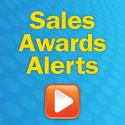Becky Johns, Vice President of MarketBridge in Bethesda, Maryland, USA, will chair the final judging committee for the Sales Achievement categories in the sales awards section of the 2014 Stevie Awards for Sales & Customer Service. (The final entry deadline for the 2014 competition is January 14 — get your entry kit here ) She shares some timely advice on the do’s and don’ts of holiday emails.
In the U.S., the dust has finally settled on yet another record-breaking Black Friday and Cyber Monday. While retailers and shoppers recover from the highs and lows of record breaking sales, near riots, and yes, even the token Taser fight, it’s time to pay homage to the real victim of the holiday shopping melée: your Inbox.
 I’ve just finished spending some time sifting through my email over the past five days. Most of the Holiday Shopper-targeted emails were caught by spam folders, which ironically enough included an email from a national grocer with a special on canned goods (yup, SPAM stuck in spam). Some of the fortunate few survived the treacherous journey past the spam detectors and managed to make it into my actual Inbox … only to lie un-opened and largely ignored over the last few days.
I’ve just finished spending some time sifting through my email over the past five days. Most of the Holiday Shopper-targeted emails were caught by spam folders, which ironically enough included an email from a national grocer with a special on canned goods (yup, SPAM stuck in spam). Some of the fortunate few survived the treacherous journey past the spam detectors and managed to make it into my actual Inbox … only to lie un-opened and largely ignored over the last few days.
Going through this exercise was both exasperating and somewhat deflating, especially when you consider that retail marketers have likely been planning and conceptualizing these Holiday Shopping emails for months. As a marketer and reformed spammer myself, I can’t help but ask the question: Is this the best we can come up with?
The answer, obviously, is NO. We can do better! And we don’t even have to Taser ourselves to get our creative juices flowing. (Side Note: why are there so many of these videos on YouTube?).
Here are my thoughts on the 4 key lessons from 5 days of Holiday Shopping emails I reviewed.
Day 1: Thursday, November 28th
Theme of Emails Received: ThanksGivingYouNotice
Apparently there’s a marketing rule that on Thanksgiving Day, every email subject line needs to involve a pun—at least, all the 84 retailer whose emails I received thought so. A quick subject line sampling (WARNING: these will likely result in you uploading a Self-Tasering video on to YouTube): “Gobble Up Our Sale,” “It’s our Thanksgiving Sales, Pilgrim,” and my personal favorite: “Did You Save Room … In Your Closet?” Don’t get me wrong, I’m all for a good pun (see the above SPAM/Spam wordplay). But on a day when you are competing with every other retailer for mindshare—all of whom apparently are trying the same tactic—none of these messages will lead to increased open rates. Beyond this, NONE of these emails had any hint of personalization, leaving me with the feeling that the Retailer was offering me nothing specific. So why should I even bother clicking on that email, as opposed to the 83 others that I received?
Lesson #1: Customize consumer messages to the individual. I’ve worked with many subscriber lists over the years and spent years cultivating engaged buyer communities solely by building relationship with prospects through email. The one thread common to all of the top-performing emails was the customization and personalization of the content and top-line message. Using what we know about the consumer can help tie relevant messaging to the right buyer at the right moment. Imagine if just one of the retailers picked up on my brand preferences and told me about an exclusive sale just for me. It would certainly peak my interest—definitely more than “Did you Save Room… In Your Closet?”
Day 2: Friday, November 29th
Theme of Emails Received: Groundhog Day
On Friday, I woke up to double the amount of emails from the previous day. The tone of the day had changed, however, with most of the emails relying on the time-sensitivity factor that marketers love to use to drive reactions: “Today Only,” “Hurry, These Deals Won’t Last,” and “Time Is Running Out.” But as the day progressed, I started to notice the same emails from retailers popping up for the second, and—I kid you not—third time. If the message had changed or evolved over the course of the day to tie together a story or theme it would have been an interesting strategy, and a compelling message to the consumer. But the same email multiple times simply smacks of laziness and, as a consumer, this would only make me twice as likely to hit the “Report As Spam” button.
Lesson #2: Reinforce your message, but do so by weaving together a story or narrative. Change the copy and/or the creative—and certainly the subject line! Sending the same email multiple times leaves a bad impression with your subscriber base. Adjusting your message can spark interest where the first email did not, thereby casting a wider net.
Over the weekend the emails continued their urgent theme. Some retailers “unexpectedly” extended sales, with new warnings about the impending end to the blowout savings. While it’s clear most retailers were following the tried and true method of putting the savings + urgency in the subject line, all these emails and offers seemed to get muddled together when they were stacked one on top of the other: “Up to 30% off everything,” “20%-40% savings,” “Half Off on Sale Items.” By adding your message to that heap, you are simply ensuring that your message will be simply passed over.
Lesson #3: Dare to be different. The few retailers that caught my attention were ones that set themselves apart by not focusing on the savings in every blast. One that induced an immediate click was titled: “Thank you for your loyalty.” In a sea of messages aimed at asking me to do something, it was refreshing to see one thanking me for simply being a previous customer. With that said, the same retailer hit me up later with a 20% off discount for my loyalty, but I dutifully obliged by checking out the offer, feeling slightly more appreciated at this point.
Day 5: Monday, December 2nd
Theme of Emails Received: Groundhog Day… Again
With Cyber Monday came a similar string of emails and tactics as Black Friday. By this point, there wasn’t much new to report—and that is precisely the point. As a consumer, I was fatigued by the emails and started to ignore emails from retailers that I knew had bombarded me over the previous 4 days. Luckily, no Tasers were in sight …
Lesson #4: Less can be more – or rather, more can be too much! In a period where we know consumers are being inundated with messages, we shouldn’t feel compelled to add to the chaos simply to compete. Consumers respect brands that respect them as valued customers and not targets. Craft the right message by personalizing and customizing it, making it unique, and be strategic in when and how often you deliver that message. At least, that’s how retailers incite action and loyalty from me—and certainly not by the traditional “Taser And Awe” tactics that flooded my Inbox over these 5 days.
About Becky Johns
Becky Johns works with clients to improve marketing and sales productivity by developing and executing integrated data-driven marketing and sales strategies. At MarketBridge, her experience centers primarily on building brand loyalty through customer acquisition, engagement, and retention programs and on developing online and social media communities. In addition, she has expertise in enabling sales teams through innovative training and sales readiness programs. In her eight years with MarketBridge, Becky has managed accounts and initiatives across healthcare, retail, travel and hospitality, financial services, and high tech industries. Prior to MarketBridge, Becky’s background in marketing and advertising included client and agency positions working in both B2B and B2C engagements.
Becky has led her teams at MarketBridge to win back-to-back Gold Stevie Awards for Sales Training Program of the Year in the 2012 and 2013 Stevie Awards for Sales & Customer Service; to be awarded the 2011 Marketing Innovation Award for Customer Retention and Loyalty by Merkle and the CMO Council; and to win a Silver Stevie Award for Brand Experience of the Year in the Marketing Awards categories of The 2013 American Business Awards. Becky's list of clients includes MasterCard, Saks Fifth Avenue, Humana, HSBC, Capital One, Guitar Center, Expedia.com, K12, Microsoft, Symantec, SAP, and Neustar.
About MarketBridge
MarketBridge is a leading global provider of digital marketing, sales enablement, and customer analytics solutions for Fortune 1000 and emerging growth companies. MarketBridge helps companies scale revenue growth and increase sales productivity by increasing digital customer engagement (social, mobile, on-line communities, e-commerce) and building robust customer analytics engines that focus marketing investments and sales activity on the right customers, with the right messaging and solution, through the right marketing and sales channels. Follow MarketBridge at: http://blog.market-bridge.com/

